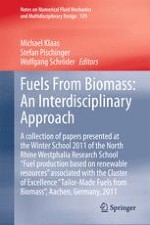2015 | Buch
Fuels From Biomass: An Interdisciplinary Approach
A collection of papers presented at the Winter School 2011 of the North Rhine Westphalia Research School "Fuel production based on renewable resources" associated with the Cluster of Excellence "Tailor-Made Fuels from Biomass", Aachen, Germany, 2011
herausgegeben von: Michael Klaas, Stefan Pischinger, Wolfgang Schröder
Verlag: Springer Berlin Heidelberg
Buchreihe : Notes on Numerical Fluid Mechanics and Multidisciplinary Design
